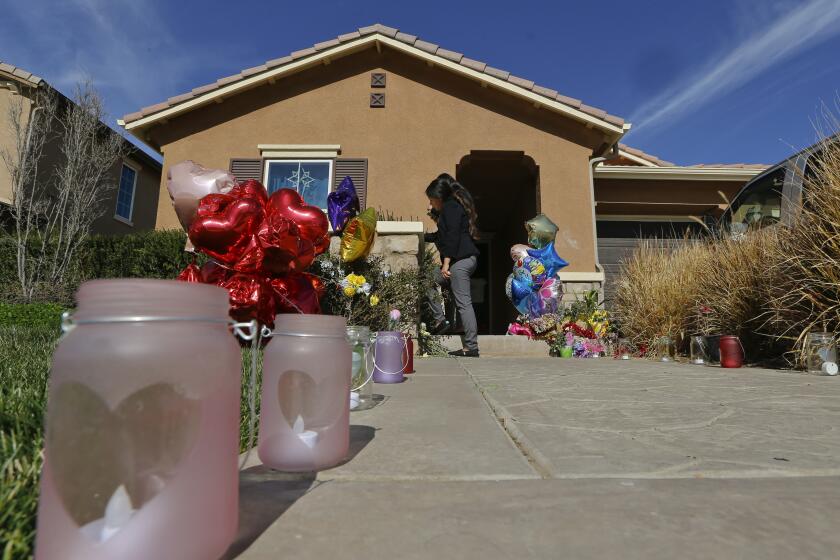Piece Offering : Mission Opens Exhibit of Relics Glorifying the Sacrifices of Saints
Relics of the saints--purported pieces of their bones, flesh or clothing or reputed artifacts from Jesus’ life--have had a long history of veneration in the Roman Catholic Church, although they are religiously out of fashion today.
But despite broad skepticism in Catholicism about the historical validity of many relics, the San Fernando Mission archival center has opened its first public exhibit of some 300 that had been in storage for years at the 200-year-old mission. The exhibits are open Monday and Tuesday from 1 to 3 p.m.
One item is an alleged fragment from the cross on which Jesus was crucified. Scoffers in church circles say that if you could assemble all the claimed pieces of Jesus’ cross, you could rebuild Noah’s Ark. Devotees scoff right back, saying that the typically tiny slivers would collectively form only a small block of wood.
Playing a key role in restoring, mounting, framing and cataloging the relics was Thomas Serafin, a Catholic parishioner in San Marino who has amassed his own collection of relics--about 800 articles he described as the largest such collection on the West Coast.
A professional photographer in Los Angeles, Serafin said he displays his collection at churches and retreat houses in hopes of reviving veneration of the saints.
His collection includes another three “documented pieces” of the cross of Jesus, he said. According to Serafin, a French researcher in the late 19th century tried to catalog all known fragments of Christ’s cross and came up with an amount that would total about a third of a cross.
While admitting the church “is a little bit leery about relics prior to the 5th century,” Serafin says his collection includes a thorn from Jesus’ crown of thorns, a bone of John the Baptist, a piece from the table of the Last Supper, and fragments from the veil of the Virgin Mary and the cloak of her husband, Joseph.
Those are some of the exact objects that have been cited as historically dubious by many embarrassed critics within the Catholic Church, especially following the period of extravagant buying and selling of relics in the Middle Ages.
Protestant reformer “Martin Luther ridiculed the church in the 16th century for some of the more fanciful items--a thorn from the crown of thorns and a twig from the burning bush of Moses--things that are more mythical than real,” said Father Thomas Rausch, who chairs the theological studies department at Loyola Marymount University.
*
During the opening sessions of the Second Vatican Council in 1962, Rausch said, a prelate from Spain, Bishop Garcia Martinez, rose to ask how much longer the church was going to venerate relics of the Virgin Mary’s milk and veil, St. Joseph’s sandals and the like.
Before the bishop was cut off by the moderator, he asked that “these things be reverently buried and heard of no more,” according to a book on Vatican II by Xavier Rynne.
At the same time, Rausch noted that few Catholics today become upset over what little attention there is paid to relics because many of them have come to tolerate so-called “popular religion” practiced by different Catholic cultures. “It is purely a matter of personal devotion,” he said.
Echoing Rausch was Msgr. Francis Weber, the Los Angeles Archdiocese archivist based at the San Fernando Mission, who said, “People are not obliged to accept this if they don’t want to.”
Despite Serafin’s assertion that he has documentation for all his relics, Weber said Friday that “All the saints we have for the last 300 or 400 years are authenticated, but the documentation wasn’t all that good before then.” Much depends on how much credibility a believer attaches to church tradition, a strong force in the Catholic faith, the priest said.
One relic on display at the mission does have good credentials--a bone fragment from the body of Father Junipero Serra, the mission pioneer whose body was exhumed for a third time at the Carmel Mission in 1984 in connection with the campaign to win sainthood for him. Serra, who was a Franciscan priest, has now been beatified, one step from Vatican approval as a saint.
“Veneration of relics is one of those aspects of Catholic faith that is not greatly emphasized presently,” said Weber. But he praised Serafin for “rescuing relics from places where they weren’t appreciated.”
Indeed, many Catholics have hidden their relics away, Serafin complained.
“I know of a Carmelite convent that actually has a trunk of relics stored in their vestibule--not being venerated, not on display, nothing,” Serafin said. “Recently I spoke at a church in Pasadena that has the relics in a drawer.”
Other times, members of religious orders have approached him and requested his aid in making relics presentable for display.
Church law--an aftermath of the Protestant Reformation--prohibits Catholics from buying or selling relics. “I chastised someone on a computer web site who is trying to sell a couple of relics for $5,000 apiece,” Serafin said.
However, Serafin added that he will “donate” money to acquire a relic, by paying for the presumed value of the locket or case that contains the relic.
“A lot of these didn’t come free,” said Serafin, motioning to a display of some of his relics. Some acquisitions come from trading duplicate relics with other owners who have more than one piece of physical remains or clothing from the same saint, he said.
*
For the first three years of collecting and taking his exhibit to churches, Serafin refused to accept donations. He started accepting contributions after his “collection got larger and required me to spend more money to move it around,” he said.
One year he took his relics to 17 churches on his free time.
It is often children who draw adults over to his exhibits, he admitted. “The kids come over and are fascinated when they learn they are looking at a bone or a piece of a heart,” he said.
“I’m not in this for the money; I’m doing this because I love the saints and their stories of sacrifice.”
More to Read
Sign up for Essential California
The most important California stories and recommendations in your inbox every morning.
You may occasionally receive promotional content from the Los Angeles Times.










